#Debian vs Ubuntu
Explore tagged Tumblr posts
Text
Linux distros - what is the difference, which one should I choose?
Caution, VERY long post.
With more and more simmers looking into linux lately, I've been seeing the same questions over and over again: Which distro should I choose? Is distro xyz newbie-friendly? Does this program work on that distro?
So I thought I'd explain the concept of "distros" and clear some of that up.
What are the key differences between distros?
Linux distros are NOT different operating systems (they're all still linux!) and the differences between them aren't actually as big as you think.
Update philosophy: Some distros, like Ubuntu, (supposedly) focus more on stability than being up-to-date. These distros will release one big update once every year or every other year and they are thoroughly tested. However, because the updates are so huge, they inevitably tend to break stuff anyway. On the other end of the spectrum are so-called "rolling release" distros like Arch. They don't do big annual updates, but instead release smaller updates very frequently. They are what's called "bleeding edge" - if there is something new out there, they will be the first ones to get it. This can of course impact stability, but on the other hand, stuff gets improved and fixed very fast. Third, there are also "middle of the road" distros like Fedora, which kind of do... both. Fedora gets big version updates like Ubuntu, but they happen more frequently and are comparably smaller, thus being both stable and reasonably up-to-date.
Package manager: Different distros come with different package managers (APT on ubuntu, DNF on Fedora, etc.). Package managers keep track of all the installed programs on your PC and allow you to update/install/remove programs. You'll often work with the package manager in the terminal: For example, if you want to install lutris on Fedora, you'd type in "sudo dnf install lutris" ("sudo" stands for "super user do", it's the equivalent of administrator rights on Windows). Different package managers come with different pros and cons.
Core utilities and programs: 99% of distros use the same stuff in the background (you don’t even directly interact with it, e.g. background process managing). The 1% that do NOT use the same stuff are obscure distros like VoidLinux, Artix, Alpine, Gentoo, Devuan. If you are not a Linux expert, AVOID THOSE AT ALL COST.
Installation process: Some distros are easier to install than others. Arch is infamous for being a bit difficult to install, but at the same time, its documentation is unparalleled. If you have patience and good reading comprehension, installing arch would literally teach you all you ever need to know about Linux. If you want to go an easier and safer route for now, anything with an installer like Mint or Fedora would suit you better.
Community: Pick a distro with an active community and lots of good documentation! You’ll need help. If you are looking at derivatives (e.g. ZorinOS, which is based on Ubuntu which is based on Debian), ask yourself: Does this derivative give you enough benefits to potentially give up community support of the larger distro it is based on? Usually, the answer is no.
Okay, but what EDITION of this distro should I choose?
"Editions" or “spins” usually refer to variations of the same distro with different desktop environments. The three most common ones you should know are GNOME, KDE Plasma and Cinnamon.
GNOME's UI is more similar to MacOS, but not exactly the same.
KDE Plasma looks and feels a lot like Windows' UI, but with more customization options.
Cinnamon is also pretty windows-y, but more restricted in terms of customization and generally deemed to be "stuck in 2010".
Mint vs. Pop!_OS vs. Fedora
Currently, the most popular distros within the Sims community seem to be Mint and Fedora (and Pop!_OS to some extent). They are praised for being "beginner friendly". So what's the difference between them?
Both Mint and Pop!_OS are based on Ubuntu, whereas Fedora is a "standalone" upstream distro, meaning it is not based on another distro.
Personally, I recommend Fedora over Mint and Pop!_OS for several reasons. To name only a few:
I mentioned above that Ubuntu's update philosophy tends to break things once a big update rolls around every two years. Since both Mint and Pop!_OS are based on Ubuntu, they are also affected by this.
Ubuntu, Mint and Pop!_OS like to modify their stuff regularly for theming/branding purposes, but this ALSO tends to break things. It is apparently so bad that there is an initiative to stop this.
Pop!_OS uses the GNOME desktop environment, which I would not recommend if you are switching from Windows. Mint offers Cinnamon, which is visually and technically outdated (they use the x11 windowing system standard from 1984), but still beloved by a lot of people. Fedora offers the more modern KDE Plasma.
Personal observation: Most simmers I've encountered who had severe issues with setting up Linux went with an Ubuntu-based distro. There's just something about it that's fucked up, man.
And this doesn't even get into the whole Snaps vs. Flatpak controvery, but I will skip this for brevity.
Does SimPE (or any other program) work on this distro?
If it works on Fedora, then it works on Mint/Ubuntu/Arch/etc., and vice versa. This is all just a question of having the necessary dependencies installed and installing the program itself properly. Some distros may have certain prerequisites pre-installed, while others don't, but you can always just install those yourself. Like I said, different distros are NOT different operating systems. It's all still Linux and you can ultimately customize it however you want.
In short: Yeah, all Sims 2-related programs work. Yes, ReShade too. It ultimately doesn't really matter what distro you use as long as it is not part of the obscure 1% I mentioned above.
A little piece of advice
Whatever distro you end up choosing: get used to googling stuff and practice reading comprehension! There are numerous forums, discord servers and subreddits where you can ask people for help. Generally speaking, the linux community is very open to helping newbies. HOWEVER, they are not as tolerant to nagging and laziness as the Sims community tends to be. Show initiative, use google search & common sense, try things out before screaming for help and be detailed and respectful when explaining your problems. They appreciate that. Also, use the arch wiki even if you do not use Arch Linux – most of it is applicable to other distros as well.
#simming on linux#bnb.txt#if anyone wants to use this as a base for a video feel free#i don't feel like like recording and editing lol
123 notes
·
View notes
Note
I want to switch from Ubuntu to a different distro, why do you like fedora?
I'm moderately confident in my skills but not so confident that I wanna start using arch
I like fedora because it has the right amount of stability vs being up to date (i call it a middle-ground between arch and debian), and it's very big so you'll have lots of support.
if you're looking at fedora the main other option is mint. unless you have a real preference between RPMs and DEBs, you should consider the angle of available desktops. Mint has the best Cinnamon experience, and Fedora officially supports tons of DEs including Gnome and KDE as flagships. If you have a DE preference then go for that.
It should be noted mint still relies on ubuntu so you're not fully going away if you pick that. There's also debian-based mint but i don't know anything about it.
My journey went from ubuntu to debian to arch to gentoo to void (non-exhaustive list) and honestly if it weren't for my love of KDE there's an equal chance i would have been on Mint instead.
Fedora requires a little more skill at setup for the proprietary nvidia drivers and for video codecs. after that it's pretty much the same thing in my experience.
14 notes
·
View notes
Note
whats the status of like. using linux on a phone. it feels like there are two parallel universes, one that kde lives in where people use linux on phones, and one where if you google linux phones you discover theyre almost usable but they can barely make phone calls or send texts and they only run on like 4 models of phone
don't have much experience with linux on phone so anyone please correct me if i'm wrong but
one of the problems with phones is that every vendor and manufacturer adds their own proprietary driver blob to it and these have to be extracted and integrated into the kernel in order for the hardware to function.
as companies don't like to share their magic of "how does plastic slab make light", reverse engineering all your hardware is quite a difficult task. Sometimes there just isn't a driver for the camera of a phone model yet because no one was able to make it work.
So naturally, this takes a lot of time and tech is evolving fast so by the time a phone is completely compatible, next generations are already out and your new model obsolete.
Also important to note: most of this work is made by volunteers, people with a love for programming who put a lot of their own time into these things, most of them after their daytime jobs as a hobby.
Of course, there are companies and associations out there who build linux phones for a living. But the consumer hardware providers, like Pinephone, Fairphone and others out there aren't as big and don't have this much of a lobby behind them so they can't get their prices cheap. Also the manufacturers are actively working against our right to repair so we need more activism.
To make the phones still affordable (and because of said above driver issues) they have to use older hardware, sometimes even used phones from other manufacturers that they have to fix up, so you can't really expect a modern experience. At least you can revive some older phones. As everything Linux.
Then there's the software providers who many of are non-profits. KDE has Plasma Mobile, Canonical works on Ubuntu Touch, Debian has the Mobian Project and among some others there's also the Arch Linux ARM Project.
That's right baby, ARM. We're not talking about your fancy PC or ThinkPad with their sometimes even up to 64-bit processors. No no no, this is the future, fucking chrome jellyfishes and everything.
This is the stuff Apple just started building their fancy line of over-priced and over-engineered Fisher-Price laptop-desktops on and Microsoft started (Windows 10X), discontinued and beat into the smush of ChatGPT Nano Bing Open AI chips in all your new surface hp dell asus laptops.
What I was trying to say is, that program support even for the market dominating monopoles out there is still limited and.... (from my own experience from the workplace) buggy. Which, in these times of enshittification is a bad news. And the good projects you gotta emulate afterwards anyways so yay extra steps!
Speaking of extra steps: In order to turn their phone into a true freedom phone, users need to free themselves off their phones warranty, lose their shackles of not gaining root access, installing a custom recovery onto their phone (like TWRP for example), and also have more technical know-how as the typical user, which doesn't quite sounds commercial-ready to me.
So is there no hope at all?
Fret not, my friend!
If we can't put the Linux into the phone, why don't we put the phone around the Linux? You know... Like a container?
Thanks to EU regulations-
(US consumers, please buy the European versions of your phones! They are sometimes a bit more expensive, but used models of the same generation or one below usually still have warranty, are around the same price as over there in Freedom Valley, and (another side tangent incoming - because of better European consumer protection laws) sometimes have other advantages, such as faster charging and data transfer (USB-C vs lightning ports) or less bloated systems)
- it is made easier now to virtualize Linux on your phone.
You can download a terminal emulator, create a headless Linux VM and get A VNC client running. This comes with a performance limit though, as a app with standard user permissions is containerized inside of Android itself so it can't use the whole hardware.
If you have root access on your phone, you can assign more RAM and CPU to your VM.
Also things like SDL just released a new version so emulation is getting better.
And didn't you hear the news? You can run other things inside a VM on an iPhone now! Yup, and I got Debian with Xfce running on my Xiaomi phone. Didn't do much with it tho. Also Windows XP and playing Sims 1 on mobile. Was fun, but battery draining. Maybe something more for tablets for now.
Things will get interesting now that Google officially is a monopoly. It funds a lot of that stuff.
I really want a Steam Deck.
Steam phones would be cool.
#asks#linux#linuxposting#kde plasma#kde#:3#kde desktop environment#arch linux#windows#microsoft#mobile phones#linux mobile#ubuntu#debian#arch#steam#gabe newell#my lord and savior
17 notes
·
View notes
Note
Ahrah: @dragongirlcock encouraged us to tell you that we've recently made the permanent jump from Windows to Linux. Your post on the topic on top of the usual Microsoft bullshit was one of the catalysts to just do it now. We did play around with several different distros in 2013 in a dual boot system, so we already had a feel for a few different ones and what we prefer in a DE and whatnot. They were all Debian based, but then we happened to stumble across Garuda KDE Dr460nized, and aside from that we really like KDE Plasma, couldn't possibly pass up on a distro with that name XD Plus it has been nice having most gaming things working out of the box and generally saved us some floundering in figuring out what all we needed, bc things have come a long way since 2013.
We've been having bit of a time trying to learn the terminal and all, and have been running into miscellaneous issues, but it has been comforting to have more expirienced people we know look at them and go, "that problem is Weird wtf???"
Sometimes we'll go looking for info and the internet is like, "Ubuntu = Linux, especially if you're a newbie, and here's how to do things without having to touch the big scary terminal :) " and anything that might be helpful it feels like there's the expectation that you know everything already if you're on Arch. *angry dragon noises*
We feel like we've somehow happened to slip through the cracks of what people "typically" do or are encouraged to do when it comes to transitioning to Linux, why is this? Bc I feel that us having more of an interest in learning more shouldn't be that odd, it seems stranger to me that there seems to be a Windows vs Mac parallel with Debian vs Arch in terms of the general information available and expectations??? Also any recommentions on ways to just stumble upon things would be helpful. Bc sure we can got to the AUR, but you have to kind of already know what you're looking for.
hell yeah !!! welcome to The Community !! (programmer socks optional d: )
oooooohhh garuda !! recognised the name and is bc it's built atop arch !!
yeag, the ubuntu-as-default assumptions (which, annoyingly, even affects debian users sometimes) are frustrating. also the "commands scawy uwu" attitude (which also seems to include "just paste this magic command in the terminal dw it's totally fine :))))" from time to time) is frustrating as well.
i don't expect every single person to manually install arch, or like gentoo or smth, spend a week configuring it, and fuckign write an emacs port to run it as a full wayland compositor, but treating computers as Magical Boxes and users as Inherently Inept really gets my goat.
idk what good communities look like anymore bc i'm not part of any and solve shit myself or by asking friends/partners, but for arch, the official wiki tends to have most things well-explained. it's not a complete solution but it should help 🩷
in conjunction w/ the arch wiki, we use stackoverflow, man pages (documentation that doesn't require a website 7 months pregnant w/ javascript octuplets ? gooodddsss it feels good), package manager search, chaotic-aur (has most aur packages pre-compiled as an additional repo, so pacman can search and install them), tldr which is simplified man pages (very handy for example commands !!)
linux systems really are a thousand rats in a trench coat, so understanding what rats ya got helps but can take time. the best way round that is have a system you can break.
for like getting from ubuntu-coded to arch-coded, we're planning some GUIDEs that may be handy. wanna cover basic terminal and shell stuff, standard unix commands, what some of the bigger trenchcoat rats are and why.
until then, if there's any specific questions feel free to drop a message here or in DMs or wherever 🩷
4 notes
·
View notes
Note
I've also been trying to get on the linux train and I'm so with you re: the lack of beginner's guides, it's actually shocking. Like, stop bickering about what distros are better for beginners, I want to know if switching is gonna wipe my data and thus if I should be more careful with my back-ups 😭 had to jump in the deep end and figure out my meagre knowledge thru fucking osmosis
Still haven't fully made the switch, but trying out different distros (aka types: what people are talking about when they say 'linux mint vs debian vs ubuntu vs gentoo vs arch'. I think there's some differences in software availability but I mostly focused on the layout differences) on a live USB was easy enough. If you look up '[distro] live install', you'll find a page on their website where you can download a file called a live image. Then you download a program called rufus and use it to burn the file to a USB (pretty sure you can reverse the process and use the USB again but I've never done that 🤷♀️). Then if you stick the USB in a USB slot and then power on your computer, it should come up with a menu to test out the distro or run a live image. Then you can play around in it and see what it feels like, though turning off your computer does end the session and reset anything you did in the session. Windows files are still available to use and look at, they're just in a seperate directory, as if on a USB stick in file explorer.
Windows fucked up so I've been living off of a live image of debian for a while, and albeit as a user with pretty low demands (basically just internet + office programs), it's been serving me pretty well.
Sadly it pretty much is a lot of figuring stuff out as you go along (plus a lot of googling things people reference), but since I'm still looking around for a proper guide before I fully commit to linux, I'll send any good ones your way.
thank u for this. i want to not use windows bc fuck microsoft and their military contracts and it's frustrating how horribly inaccessible this is while the users pretend it's easy and simple. someday ill figure it out i guess
3 notes
·
View notes
Text


Ubuntu’s homepage vs Debian’s home page.
2 notes
·
View notes
Text
Price Comparison: DigitalOcean vs. Linode vs. Vultr vs. Amazon Lightsail vs. SSD Nodes vs. Many Others
Whew! That's quite a tough headline to swallow. But choosing the right cloud hosting provider for your next virtual private server (VPS) shouldn't be difficult, too. Sometimes, it just comes down to price. Whether you're a cash-strapped student or just someone who wants to run a few essential applications without emptying our your wallet, you're in luck—there are a lot of low-cost options these days. That's why we're breaking down a bunch of 1GB RAM KVM plans in this new cloud hosting price comparison.
An unmanaged hosting service means that you have to install applications and administer the server yourself. KVM offers more flexibility than other options, like OpenVZ, but comes at a slight cost increase. Still, we recommend KVM for most users. At the very least, each of these providers offers Ubuntu, Debian, and CentOS. Read more...
2 notes
·
View notes
Text
Old Kisekae art collection (part 2, Gijinka edition)
Following from my previous batch, this collection will feature original characters based on companies, software, programs, and hardware, as well as characters from established franchises that thrived off the gijinka concept.

A nonet of cat girls based on versions 10.0 to 10.8 of Mac OS, with each having a symbol of the system's logo littered in their designs, as well as a few design references to Hololive's alumni.
(Note: The placement of the "X" symbols will be noted in brackets)
From left to right: Cheetah (hips), Puma (hair clips), Jaguar (necklace), Panther (bow tie), Tiger (hair buns), Leopard (hair bow), Snow Leopard (hair clip), Lion (choker), and Mountain Lion (bow tie)
(Puma and Lion in particular are modeled after Fubuki Shirakami and Botan Shishiro respectively)

OC Console-tans + Sega Hard Girls, substituting the Neptunia cast (at the time) in order of debut (with the handheld-tans being put aside their sisters), though its more in terms of the systems they're based on rather than personality (and in the cases of Wii and DS, they're basically the opposite of Blanc and Rom/Ram).
From left to right: Sega Saturn (as Neptune), Game Gear (Nepgear), PS3 (Noire), PSP (Uni), Wii (Blanc), DS (Rom/Ram), Xbox 360 (Vert), Sega Genesis (Plutia), and Dream Cast (Uzume)

OC OS-tans + Anri from Neptunia: Sisters vs Sisters and Nanami Madobe from the Microsoft Japan ads, adjusted to personify the software as a whole (and also have the Xbox's "X" as an emblem on her bow)
From left to right: Chrome OS, Linux, Windows (Nanami), (Modern) Mac OS, IOS (Anri), and Andorid

OC Channel-tans with alternate designs, along with the addition of Discovery Family/Hub Network/Discovery Kids. This was the second-to-last illustration I depicted with their "canonical" Channel-tan designs before moving away from redesigning established characters from a meme.
Of the design differences from my earlier and current drawings featuring them include Nickelodeon having brown hair, a hair clip, and her eyewear being represented as her with beaed eyes; Disney Channel having pigtail-styled buns (or buns-styled pigtails), gloves, and a windowed (?) shirt; and Cartoon Network having multicolored hair at the back (blue, yellow, and pink in this case), swept hair, and tomboyish sidetails with polkabotted bows tying at the end.

Redesigned versions of my OC OS-tans reinterpreted as CPUs (Console Patron Units) from the Neptunia series.
This Windows in particular is modeled after Mine Yoshizaki's OS Idol Win-chan illustrations; Mac OS is slightly altered from the sketch I originally depicted her as, Linux is the same, but with minor adjustments (namely, giving her cap eyes), and Chrome OS is given a completely new design.
This is the last illustration to depict the stand-in to Linux as a catch-all to the system's distributions rather than personifying the distros themselves.

PlayStation-tans + Sony Interactive Entertainment-tan (who I modeled after Noire from the Neptunia series).
From left to right: SIE, PS1, PS2, PSP, PS3, PSVita, PS4, and PS5

An additional illustration showcasing the PS girls in their everyday lives as how I (used to) picture them: The consoles arguing, the handhelds minding their business, and SIE being too overworked to do anything about it
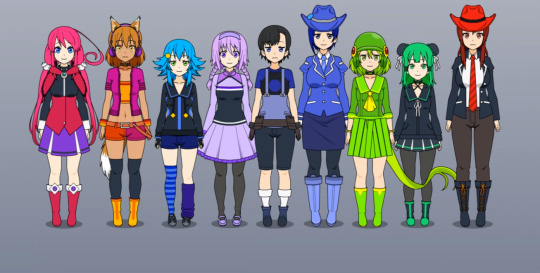
OC OS-tans based on the Linux distribution software, AKA the Linux Distro Girls.
From left to right: Debian, Ubuntu, Arch Linux, Gentoo, Slackware, Fedora, Open SUSE, Manjaro, and Red Hat
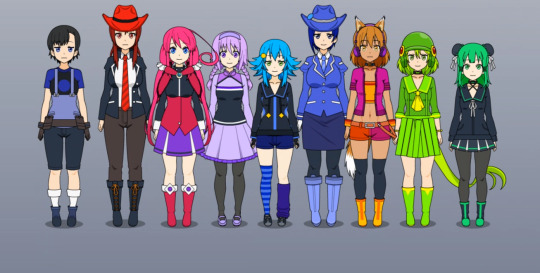
Order by year: Slackware (1993), Red Hat (1995), Debian (1993), Gentoo (2002), Arch Linux (2002), Fedora (2003), Ubuntu (2004), Open SUSE (2006), and Manjaro (2011)
(Side note: I placed Debian after Red Hat instead of before since I erroneously thought the software debuted in 1996; Open SUSE originally debuted in 1994 as SUSE Linux)

Order by height: Manjaro, Arch, SUSE, Gentoo, Debian, Slackware, Ubuntu, Fedora, and Red Hat
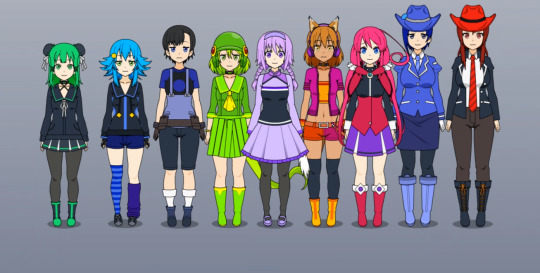
Order by bust size: Manjaro, Arch, Slackware, SUSE, Gentoo, Ubuntu, Debian, Fedora, and Red Hat
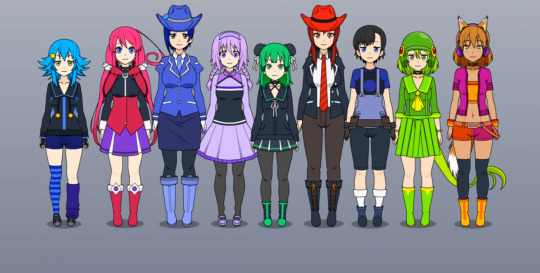
Order by name: Arch, Debian, Fedora, Gentoo, Manjaro, Red Hat, Slackware, SUSE, and Ubuntu
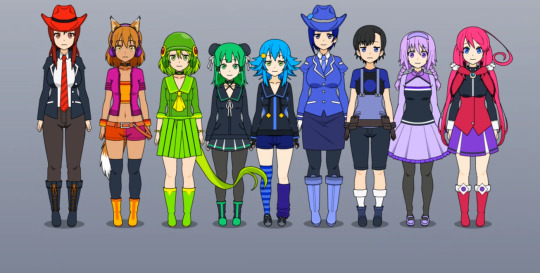
Order by color: Red Hat (red), Ubuntu (orange), SUSE (lime green), Manjaro (green), Arch (sky blue), Fedora (blue), Slackware (dark blue), Gentoo (lilac), and Debian (pink)

The Linux Distro Girls in high-school; Debian, Ubuntu, Arch, Gentoo, Slackware, SUSE, and Manjaro as the students, and Fedora and Red Hat as the faculty.

The Linux Distro Girls at the beach: Arch and Slackware enviously looking at Red's assets as she shows them off to them, Debian and Gentoo playing volleyball, Manjaro staring at Fedora's abs, and Ubuntu trying to catch a crazy (and blurry) SUSE.

An alternate version without SUSE's blur.

An extra image of SUSE looking to the void with a smile on her face. Brr...
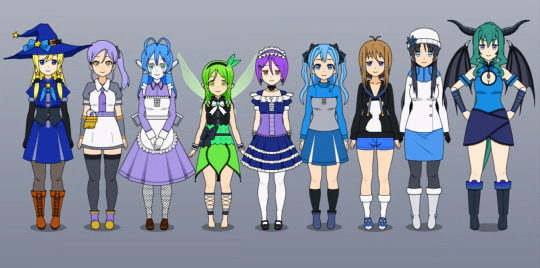
The second batch of the Linux Distro Girls.
From left to right: Mandriva, Knoppix, Zorin, Linux Mint, CentOS, Mageia, PCLinuxOS, NixOS, and Kali Linux.
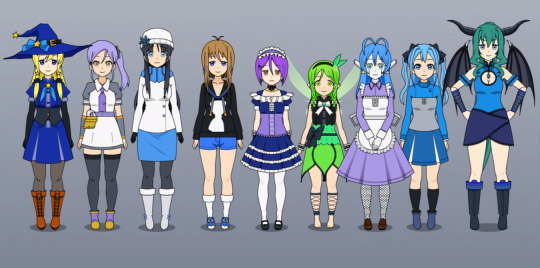
Order by year: Mandriva (1998), Knoppix (2000), NixOS (2003), PCLOS (2003), CentOS (2004), Linux Mint (2006), Zorin (2009), Mageia (2011), and Kali (2013)
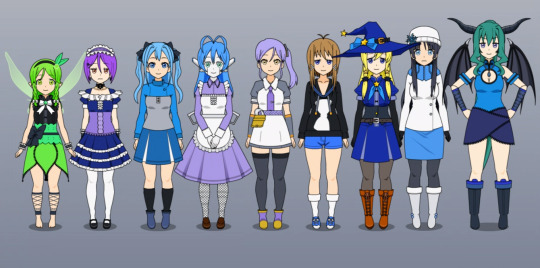
Order by height: Linux Mint, CentOS, Mageia, Zorin, Knoppix, PCLOS, Mandriva, NixOS, and Kali
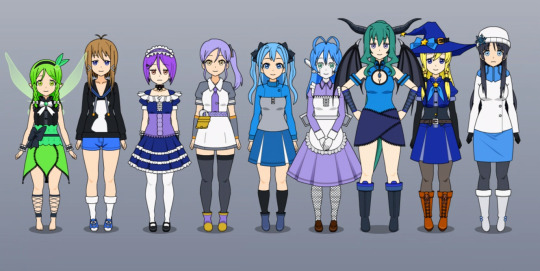
Order by bust size: Linux Mint, PCLOS, CentOS, Knoppix, Mageia, Zorin, Kali, Mandriva, and NixOS
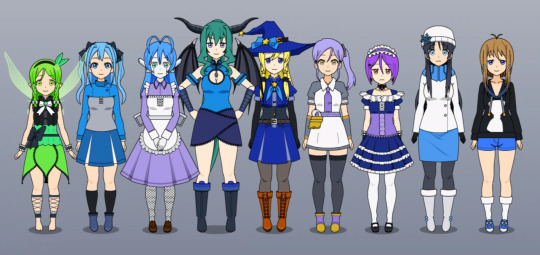
Order by color: Linux Mint (lime green), Mageia (sky blue), Zorin (sky blue), Kali (sky? blue), Mandriva (blue), Knoppix (lilac), CentOS (purple), NixOS (white), and PCLOS (black)
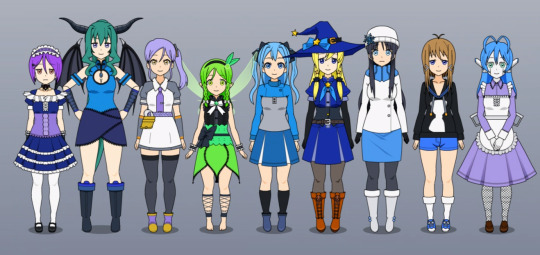
Order by name: CentOS, Kali, Knoppix, Linux Mint, Mageia, Mandriva, NixOS, PCLOS, and Zorin

The Linux Distro Girls as idols singers.
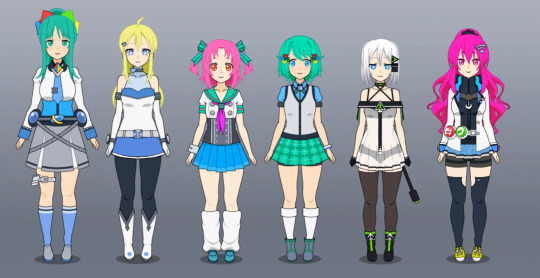
OC CPUs based on operating systems, featuring Anri and Maho as the IOS and Android stand-ins
The names for the original characters are Azul (Window), Maki (Mac OS), Kurome (Chrome OS) - not to be confused with Kurome Ankokuboshi, and Blu (Windows Mobile/Phone).
This is an edit I did in IbisPaintX. Here's the original version ⬇
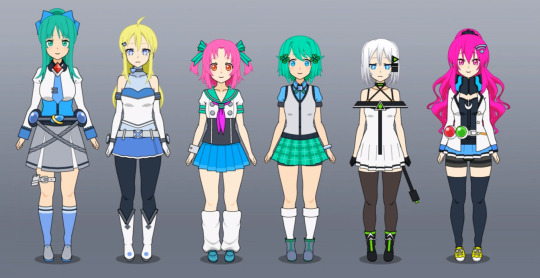
Besides that, we also have:
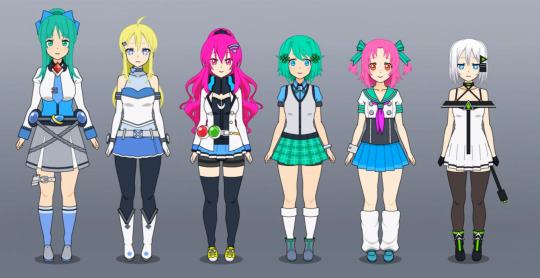
Order by height: Azul, Maki, Maho, Blu, Kurome, and Anri

Order by bust size: Azul, Maho, Maki, Anri, Blu, and Kurome
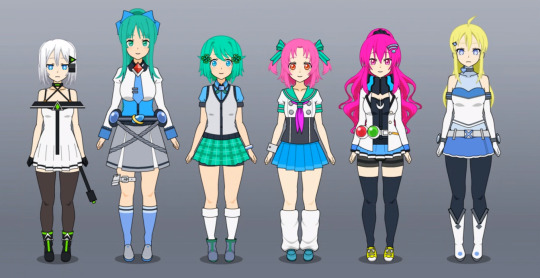
Order by name: Anri, Azul, Blu, Kurome, Maho, and Maki
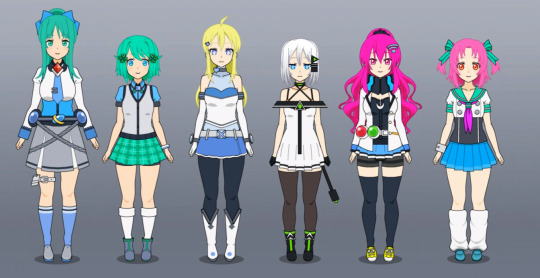
Order by year: Azul (1985), Blue (2000), Maki (2001)*, Anri (2007), Maho (2008), and Kurome (2011)
Also note that I sorted the characters heights and bust sizes from right-to-left order instead of left-to-right.
* = Current Mac OS
And since Tumblr only allows 30 images per post, I'll have to upload the third batch with the remaining images.
#kisekae#kisekae 2#gijinka#original characters#oc and canon#os tan#console tan#channel tan#company tan#hyperdimension neptunia#neptunia#sega hard girls
0 notes
Text
Why Ubuntu is the Perfect Gateway into the Linux World

Linux can feel like a daunting frontier for newcomers. Its reputation for complexity and command-line wizardry often scares off those curious about open-source operating systems. But there’s a friendly entry point that makes the transition smooth and welcoming: Ubuntu. Known for its accessibility and robust community, Ubuntu is the perfect gateway into the Linux world.
This article explores why Ubuntu stands out as the ideal starting point for anyone looking to dive into Linux, covering its user-friendly design, vast software ecosystem, strong community support, and versatility across devices.
A User-Friendly Design That Eases the Learning Curve

Stepping into Linux can feel like learning a new language, but Ubuntu makes it as approachable as a casual conversation. This is why Ubuntu is the perfect gateway into the Linux world: it prioritizes simplicity over complexity. Unlike some Linux distributions that demand technical know-how from the get-go, Ubuntu’s graphical interface, known as GNOME by default, feels familiar to anyone who’s used Windows or macOS. The desktop is clean, intuitive, and packed with thoughtful touches, like a dock for quick app access and a search bar that finds files or settings in seconds.
New users don’t need to wrestle with the terminal to get started. Installing Ubuntu is straightforward, with a guided setup that walks you through partitioning drives and configuring settings. Once installed, the system feels polished and responsive. You can tweak wallpapers, arrange icons, or adjust settings without diving into config files. For those nervous about leaving their comfort zone, Ubuntu’s design bridges the gap between proprietary systems and the Linux world, reinforcing why Ubuntu is the perfect gateway into the Linux world.
It’s not just about looks. Ubuntu’s default apps, like Firefox for browsing, LibreOffice for productivity, and Rhythmbox for music, are pre-installed and ready to go. This means you can hit the ground running without needing to hunt for software. For anyone worried about Linux being “too technical,” Ubuntu proves you can explore open-source without a steep learning curve.
A Vast Software Ecosystem at Your Fingertips
One of Ubuntu’s biggest strengths is its access to a massive library of software, making it a playground for both beginners and seasoned users. The Ubuntu Software Center is a one-stop shop where you can browse, install, and update thousands of applications with a single click. Whether you need a video editor, a code editor, or a game to unwind, Ubuntu has you covered.
Here’s why the software ecosystem makes Ubuntu the perfect gateway into the Linux world:
Snap and Flatpak Support: Ubuntu embraces modern packaging formats like Snap and Flatpak, ensuring you get the latest versions of apps like Slack, Spotify, or VS Code. These formats simplify installation and updates, even for proprietary software.
Debian Roots: Built on Debian, Ubuntu inherits a vast repository of packages accessible via the APT package manager. This gives users access to a wide range of tools, from server software to niche utilities.
Cross-Platform Compatibility: Many apps available on Ubuntu have versions for Windows or macOS, making the switch less jarring. For example, GIMP (a Photoshop alternative) or Blender (for 3D modeling) work similarly across platforms.
This ecosystem empowers users to experiment without feeling overwhelmed. Want to try coding? Install Python or Java with a single command. Need a creative suite? Grab Krita or Inkscape from the Software Center. Ubuntu’s software availability ensures you can tailor your system to your needs, whether you’re a student, developer, or casual user.
A Supportive Community That Has Your Back
Linux can seem intimidating when you hit a snag, but Ubuntu’s community makes troubleshooting feel like a group effort. With millions of users worldwide, Ubuntu boasts one of the largest and most active communities in the Linux world. Whether you’re stuck on a driver issue or curious about customizing your desktop, help is never far away.
The community shines through in several ways:
Forums and Q&A Sites: The Ubuntu Forums and Ask Ubuntu (part of Stack Exchange) are treasure troves of advice. Search for your issue, and chances are someone’s already solved it. If not, post a question, and friendly users will chime in.
Tutorials and Documentation: Ubuntu’s official documentation is clear and beginner-friendly, covering everything from installation to advanced tweaks. Countless blogs and YouTube channels also offer step-by-step guides tailored to new users.
Local User Groups: Many cities have Ubuntu or Linux user groups where enthusiasts meet to share tips and troubleshoot together. These groups make the Linux world feel less like a solo journey and more like a shared adventure.
This support network is a game-changer for newcomers. Instead of feeling lost in a sea of terminal commands, you’re backed by a global community eager to help. It’s like having a knowledgeable friend on speed dial, ready to guide you through any hiccup.
Versatility Across Devices and Use Cases

Ubuntu’s flexibility is another reason it’s the perfect gateway into the Linux world. Whether you’re reviving an old laptop, setting up a home server, or building a developer workstation, Ubuntu adapts to your needs. It runs on everything from low-spec netbooks to high-end workstations, making it a go-to choice for diverse hardware.
For casual users, Ubuntu’s lightweight editions, like Xubuntu or Lubuntu, breathe new life into aging machines. These variants use less resource-hungry desktops while retaining Ubuntu’s core features. Developers love Ubuntu for its robust tools, such as Docker, Kubernetes, and Git, preconfigured for coding environments. Even gamers are finding Ubuntu increasingly viable, thanks to Steam’s Proton and Wine for running Windows games.
Beyond desktops, Ubuntu powers servers, cloud infrastructure, and even IoT devices. Companies like Canonical (Ubuntu’s developer) ensure regular updates and long-term support (LTS) releases, which are stable for five years. This versatility means you can start with Ubuntu on a personal laptop and later explore its server or cloud capabilities without switching distributions.
The ability to customize Ubuntu is a bonus. Want a macOS-like look? Install a theme. Prefer a Windows vibe? Tweak the layout. This adaptability lets users experiment with Linux’s possibilities while staying in a familiar environment. Ubuntu’s balance of stability and flexibility makes it a launching pad for exploring the broader Linux ecosystem.
Conclusion
Ubuntu stands out as the ideal entry point for anyone curious about Linux. Its user-friendly design welcomes beginners with a familiar interface and straightforward setup. The vast software ecosystem ensures you have the tools you need, from creative apps to developer suites.
A supportive community is there to guide you through challenges, making the Linux world feel less intimidating. And with its versatility across devices and use cases, Ubuntu grows with you as your skills and needs evolve. For anyone looking to dip their toes into open-source waters, Ubuntu is the perfect gateway into the Linux world, a friendly, flexible, and powerful starting point for an exciting journey.
#WhyUbuntuisthePerfectGatewayintotheLinuxWorld#CommonLinuxMythsBusted:WhatNewUsersShouldReallyExpect
1 note
·
View note
Text
Unlock High-Performance with CloudMinister’s VPS Hosting Solutions
In today’s digital-first world, businesses need power, control, and scalability in their hosting solutions—without the cost of dedicated servers. Virtual Private Server (VPS) Hosting strikes the perfect balance between shared hosting and dedicated servers, offering enhanced performance, security, and flexibility.
CloudMinister provides enterprise-grade VPS hosting with robust infrastructure, 24/7 support, and customizable solutions tailored to your business needs.
Why Choose VPS Hosting?
VPS hosting gives you dedicated resources within a virtualized environment, offering:
Better Performance – Guaranteed CPU, RAM, and storage with no noisy neighbors. Full Root Access – Complete control over your server environment (install custom software, adjust settings). Enhanced Security – Isolated environment reduces risks compared to shared hosting. Scalability – Easily upgrade resources as your business grows. Cost-Effective – More affordable than a dedicated server, with similar benefits.
CloudMinister’s VPS Hosting Solutions
1. Managed VPS Hosting
24/7 monitoring, updates, and security patches handled by our experts.
Ideal for businesses that want high performance without server management hassles.
2. Self-Managed VPS Hosting
Full root access for developers and IT teams who want complete control.
Best for custom applications, game servers, and advanced configurations.
3. Windows & Linux VPS Hosting
Supports Windows Server (for .NET, MSSQL, Remote Desktop) and Linux (Ubuntu, CentOS, Debian).
Optimized for ERP, CRM, eCommerce, and databases.
4. SSD-Powered VPS Hosting
Blazing-fast NVMe/SSD storage for quicker load times and better reliability.
Perfect for high-traffic websites and resource-intensive apps.
Key Benefits of VPS Hosting with CloudMinister
99.9% Uptime Guarantee – Reliable hosting with minimal downtime. DDoS Protection & Firewalls – Advanced security to safeguard your data. Instant Scalability – Upgrade CPU, RAM, or storage with a few clicks. 24/7 Expert Support – Get help whenever you need it.
Who Should Use VPS Hosting?
Growing websites needing more power than shared hosting.
E-commerce stores requiring fast, secure transactions.
Developers needing a sandbox for testing and deployment.
Business applications (ERP, CRM, VoIP) that demand stability.
VPS vs. Shared Hosting vs. Cloud Hosting

VPS is ideal for businesses that need a balance of affordability, control, and performance.
Final Thoughts
Whether you’re running a high-traffic website, SaaS platform, or business application, VPS hosting provides the power, security, and flexibility you need. CloudMinister’s VPS solutions come with premium hardware, expert support, and hassle-free management—so you can focus on growth.
0 notes
Note
so i've used linux as a daily driver all my life - kid me was *very* into free stuff i could do with a computer - but I've mostly kept to the 'user-friendly' debian-based distros like ubuntu and mint. I'm probably going to build an arch system next time I need to do a reinstall on my daily driver, but now's not the time. That said, I finally made the switch from pulse to pipewire and I'm losing my mind why did we live like that for so long?
and pulseaudio, despite receiving a ton of backlash for its issues, was already a huge improvement for home users over your options of rawdogging ALSA (exclusive device access so no sharing between applications), or old OSS which lacked Bluetooth support (though did support per-application volume control). New OSS is apparently alright but haven't used it.
ALSA + pulseaudio was my first experience of functioning sound (we tried so hard to get onboard sound working in the mid 00s and it just wasn't).
but pipewire ?? all the power and flexibility of JACK while being simple and integrating into anything supporting pulseaudio. I could never go back !!
glad you made the switch and are enjoying it !! also both arch and void have installers now that still shoe you what they're doing but walk you through it vs doing a manual install. and you can absolutely slap your usual DE and applications on top of it if you want something that Just Works :3
12 notes
·
View notes
Link
#Automation#cloud#configuration#containerization#deploy#DevOps#Docker#feedaggregator#FreshRSS#Linux#Monitoring#news#open-source#Performance#Privacy#RSSreader#self-hosted#Server#systemadministration#updates#webapplication
0 notes
Text
Red Hat Enterprise Linux
Red Hat Linux was one of the most popular Linux distributions (distros) for both servers and desktops before it was discontinued. It played a key role in the development of Linux as a mainstream operating system. Here's a breakdown of Red Hat Linux and its modern successor:
1. Red Hat Linux (1994–2004):
Initial Release: Red Hat Linux was first released in 1994 by Red Hat, Inc., founded by Marc Ewing and Bob Young. It became one of the most widely used distributions, known for its stability and reliability, which made it popular in enterprise environments.
Package Management: It used the Red Hat Package Manager (RPM) format for installing and managing software, which became one of the most common package management systems in the Linux world.
Discontinuation: Red Hat discontinued Red Hat Linux in 2004, transitioning to a more enterprise-focused distribution—Red Hat Enterprise Linux (RHEL).
2. Red Hat Enterprise Linux (RHEL):
Enterprise-Focused: RHEL was launched to focus on businesses and large organizations. It is a paid, subscription-based Linux distribution that offers long-term support, regular security updates, and extensive hardware certification.
Key Features:
Stability: RHEL is designed for mission-critical environments, ensuring a stable platform for servers, databases, and applications.
Security: Features like SELinux (Security-Enhanced Linux) provide an additional layer of security for enterprise environments.
Long-Term Support: Each major version of RHEL is supported for around 10 years (with 5 years of full support and 5 years of maintenance support).
Software Repositories: RHEL includes official repositories containing enterprise-grade software and has commercial support from Red Hat.
RHEL vs. Fedora vs. CentOS:
Fedora: This is the upstream, community-driven version that serves as a testing ground for RHEL features.
CentOS: CentOS was originally a free, community-supported clone of RHEL. However, Red Hat shifted its focus in late 2020 to CentOS Stream, which serves as a rolling-release version that is positioned between Fedora and RHEL.
3. Modern Usage:
RHEL is widely used in enterprise environments, especially for web servers, application servers, cloud computing, and more. Red Hat also offers a variety of tools and services around RHEL, including automation, containerization (via OpenShift), and Kubernetes support.
4. Red Hat's Role in the Linux Ecosystem:
Open Source Commitment: Red Hat has been a significant contributor to the open-source community, funding many projects and sponsoring key development initiatives.
Acquisition by IBM: In 2019, IBM acquired Red Hat for $34 billion, further strengthening Red Hat's position as a leader in enterprise Linux solutions.
5. Alternatives:
Other Linux Distros: While Red Hat (and its enterprise variants) is quite popular, there are many alternatives such as Ubuntu, Debian, SUSE, and Arch Linux, each with different goals, community support, and use cases.
for more details please visit
www.qcsdclabs.com,
www.hawkstack.com
0 notes
Text
Ubuntu 20.04 LTS vs. Linux Mint 20: Welches soll ich installieren?
Einblick: Ubuntu 20.04 LTS vs. Linux Mint 20: Welches soll ich installieren? Werfen wir einen Blick auf die Liste der Funktionen, die beide Betriebssysteme besitzen. Beide Linux-Betriebssysteme sind sehr beliebt und werden oft als perfekte Alternative zu Windows-Betriebssystemen angesehen. Ubuntu vs. Linux Mint Ubuntu basiert auf Debian Linux. Die erste Version oder Initialversion, Ubuntu 4.10…
0 notes
Text
Debian vs. Ubuntu
Pierwszy artykuł z nowej serii Distro vs. Distro postanowiłem poświęcić dystrybucjom Debian i Ubuntu https://linuxiarze.pl/debian-vs-ubuntu/

1 note
·
View note